

 |
Search the Site with

|
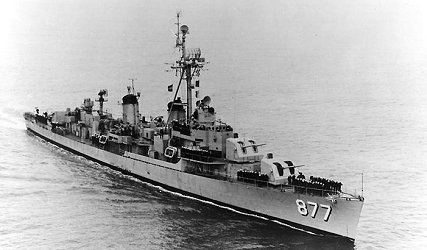 | Sorry, no coat of arms available. |
USS PERKINS was one of the GEARING - class destroyers and the third ship in the Navy to bear the name. Both decommissioned and stricken from the Navy list on January 15, 1973, the ship was transferred to Argentina the same day and was recommissioned as COMODORE PY. Finally decommissioned in 1984, the destroyer was subsequently scrapped.
| General Characteristics: | Awarded: 1943 |
| Keel laid: June 19, 1944 | |
| Launched: December 7, 1944 | |
| Commissioned: April 4, 1945 | |
| Decommissioned: January 15, 1973 | |
| Builder: Consolidated Steel Corp., Ltd., Orange, TX | |
| FRAM II Conversion Shipyard: Long Beach Naval Shipyard, Long Beach, CA | |
| FRAM II Conversion Period: March 1962 - December 1962 | |
| Propulsion system: four boilers, General Electric geared turbines; 60,000 SHP | |
| Propellers: two | |
| Length: 391 feet (119.2 meters) | |
| Beam: 41 feet (12.5 meters) | |
| Draft: 18.7 feet (5.7 meters) | |
| Displacement: approx. 3,400 tons full load | |
| Speed: 34 knots | |
| Aircraft after FRAM II: two DASH drones | |
| Armament after FRAM II: three 5-inch/38 caliber twin mounts, Mk-32 ASW torpedo tubes (two triple mounts), two Hedgehogs Mk-10 | |
| Crew after FRAM II: approx. 275 |
Crew List:
This section contains the names of sailors who served aboard USS PERKINS. It is no official listing but contains the names of sailors who submitted their information.
USS PERKINS Cruise Books:
USS PERKINS History:
USS PERKINS was laid down 19 June 1944 by the Consolidated Steel Corp., Ltd., Orange, Tex.; launched 7 December 1944; sponsored by Mrs. Larz Anderson; and commissioned 5 April 1945, Comdr. T.M. Fleck in command.
Following shakedown off Cuba, PERKINS entered the Norfolk Navy Yard for conversion to a radar picket destroyer. In July 1945 she underwent refresher training, rendezvoused with BOXER (CV 21) on the 20th, and headed for the Pacific. At Pearl Harbor she joined DesDiv 52 and on 19 August sailed for the Far East. She entered Tokyo Bay the day of the formal Japanese surrender, 2 September, and on the 3rd joined TF 38. Operations in the Marshalls, Marianas, and off Japan followed and in April 1946 she returned to Pearl Harbor. On the 28th she arrived at San Diego whence she operated for the next year.
In May 1947, she returned to the Far East for three months on the China station, two weeks of which were spent off Chinwangtao, on the Gulf of Po Hai, observing Communist Chinese forces.
PERKINS returned to California in October and in January 1948 sailed to the Marshalls for the atomic test series operation “Sandstone”. Overhaul followed her return to San Diego in June and on 4 January 1949 she departed the west coast for another tour off the China coast. Arriving at Tsingtao 7 February, she was redesignated DDR 877 on the 18th. Scheduled exercises soon began, but, in addition, she was called on to lift foreign residents of Tsingtao to Hong Kong as Communist forces took over the former city in May. In June she battled her first typhoon, and after visiting Singapore in August, she returned to San Diego.
Engaged in training exercises off the west coast and yard overhaul for the next year, PERKINS, reassigned to DesDiv 11, sailed west again in mid-August 1950. She served on SAR station in the central Pacific, returned to the west coast in October, and on 2 February 1951 got underway for the embattled coast of Korea. Between March and September she performed screening and plane guard duties for the carriers of TF 77 and carried out gunfire support and shore bombardment missions with TF 95. On 25 September PERKINS arrived at Yokosuka from the bombline and the next day continued on toward the United States. In June 1952 she returned to Korea. She spent July entirely on the bombline, shifted briefly to TF 77, then steamed south for duty on the Taiwan Patrol. By 8 September she was back on the bombline. On 15 October, while covering minesweeping operations preparatory to an amphibious feint against Kojo, 35 miles north of the battlefront, one of her crew was killed and 17 were wounded by 2 near misses from Communist shore batteries. Only slightly damaged, she continued her combat activities and for the remainder of her tour alternated gunfire support operations with carrier escort duties.
At the end of the year PERKINS returned to the United States. In July 1953 she completed a six month overhaul and in August she returned to the Far East. Six months she patrolled off the Korean Truce line and Taiwan Strait and participated in exercises from Japan to the Philippines. After that deployment PERKINS continued to rotate between duty with the 7th Fleet in the western Pacific and operations with the 1st Fleet off the west coast. In July 1956 she contributed to the information gathering effort of the IGY by “chasing” weather balloons and in September 1959 helped TF 77 forestall overt hostilities during the Laotian crisis. In March 1962 she entered the Long Beach Naval Shipyard for Fleet Rehabilitation and Modernization. Redesignated DD 877, 30 September, she emerged from the FRAM II overhaul and conversion in December with a new superstructure configured for DASH.
The “new” destroyer spent the next ten months exercising off the west coast and in mid-October 1963 resumed annual deployments to WestPac, her first mission to conduct operations with the carrier HANCOCK in the South China Sea. Continuing to alternate 7th Fleet and 1st Fleet duty tours into 1970, each of PERKINS’s WestPac deployments have returned her to the South China Sea where, off the coast of Viet Nam, she has performed screening and plane guard duties for TF 77, provided gunfire support to Allied ground forces, and intercepted North Vietnamese logistics craft navigating along the indented coastline to supply areas in South Viet Nam.
Assigned to Naval Reserve training service after her last western Pacific visit, she spent most of 1971 and all of 1972 operating along the U.S. West Coast, with side trips to Alaska and Hawaii. USS PERKINS was decommissioned in mid-January 1973 and transferred to Argentina. Renamed Comodore Py, she served in that nation's navy until 1984.
About the Ship's Name:
George Hamilton Perkins was born in Hopkinton, New Hampshire, on 20 October 1836. He was appointed an Acting Midshipman in October 1851 and graduated from the U.S. Naval Academy with the class of 1856. During the rest of that decade Midshipman Perkins served at sea on the sloop of war CYANE, the storeship RELEASE and the steamer SUMPTER. He attained the ranks of Master in 1859 and Lieutenant in February 1861, on the eve of the Civil War. Perkins spent the conflict's first several months in the SUMPTER, operating on anti-Slavery patrols. In late 1861 he became Commanding Officer of the new gunboat CAYUGA, in which he performed distinguished service during the 1862 campaigns to capture New Orleans and the lower Mississippi River. He was next Executive Officer of the steam sloop PENSACOLA, receiving promotion to Lieutenant Commander at the end of 1862. His service on the Mississippi and in the Gulf of Mexico continued in 1863-1865, including command of gunboats NEW LONDON and SCIOTA, and the monitor CHICKASAW. While in the latter ship, his aggressive and effective conduct during the August 1864 Battle of Mobile Bay was a major factor in the capture of the Confederate ironclad TENNESSEE.
In the years immediately following the Civil War Lieutenant Commander Perkins was Superintendent of Iron-Clads at New Orleans, Executive Officer of the steam sloop LACKAWANNA in the North Pacific, and had ordnance duty at the Boston Navy Yard. Reaching the rank of Commander in early 1871, he spent the next decade as Commanding Officer of the storeship RELIEF and gunboat ASHUELOT and had further shore duty at Boston. Perkins was promoted to Captain in 1882 and commanded the Pacific Station flagship HARTFORD during the mid-1880s. Captain Perkins' subsequent active service was limited to court-martial duty. He was transferred to the Retired List in October 1891, but in 1896 received a Congressionally authorized promotion to the retired rank of Commodore in recognition of his gallantry and skill during the Battle of Mobile Bay three decades earlier. Commodore Perkins died at Boston on 28 October 1899.
USS PERKINS Image Gallery:
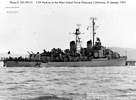 | 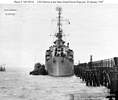 | 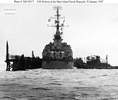 | 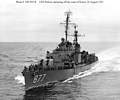 | 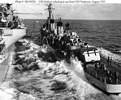 |
 |
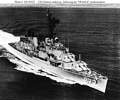 |
 Back to Destroyers list.
Back to Destroyers list.  Back to ships list.
Back to ships list.  Back to selection page.
Back to selection page.  Back to 1st page.
Back to 1st page.